Sassuolo are by far one of the most exciting teams to watch in world football at the moment and have been since the beginning of the season.
I Neroverdi started the 2020/21 Serie A campaign in style as the league’s entertainers and even took the top spot for a brief period of time back in November. Roberto De Zerbi’s side were a small fish in a big pond at the top end of the table and were holding their own against some of Europe’s biggest clubs, including Juventus, Milan, and Internazionale.
Unfortunately for Sassuolo, coming into December, until recently, their form took a turn for the worst as the team are now sitting eighth in the league table as of writing and look very much out of the race for UEFA Champions League football next season.
However, it has not been their attacking style that has let them down. Sassuolo are still performing quite consistently in most attacking metrics, but it is their defending that has been the side’s problematic area and the reason for their downturn in fortunes. I Neroverdi have failed to keep a single clean sheet in all competitions since the 11 December, a 1-0 victory over Benevento.
This article will be a tactical analysis, in the form of a scout report, of Sassuolo in the past couple of weeks. Mainly, it will be an analysis of the defensive tactics deployed by De Zerbi, as well as structural problems within the side to see why they are struggling so much at the back.
Firstly, before proceeding, it must be noted that this article was written prior to Sassuolo’s game against Bologna at the weekend and so certain statistics which will be discussed may have changed since.
Set-up and intensity
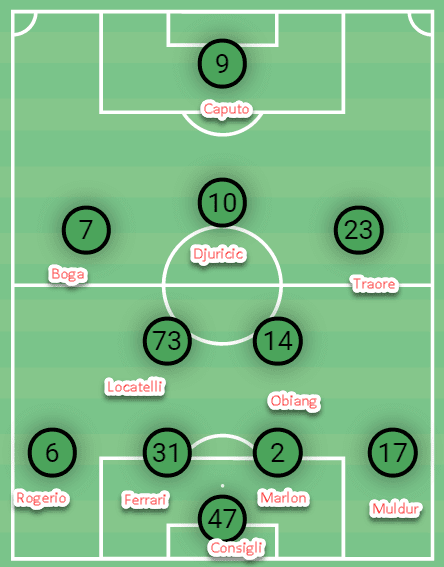
Sassuolo have used the 4-2-3-1 formation in 65 percent of their games this season in all competitions and has been De Zerbi’s favoured formation throughout his time in charge. The 4-2-3-1 system gives them a lot of balance when in both the attacking and defensive phases.
The image above is an example of a typical lineup that De Zerbi deploys in their 4-2-3-1 system. Andrea Consigli typically starts in goal, behind a backline made up of Rogerio, Gian Marco Ferrari, Marlon Santos/Vlad Chiriches, and Mert Muldur. The double-pivot protecting the backline has usually consisted of Manuel Locatelli and Pedro Obiang with Filip Djuricic ahead at number 10, flanked by both Jeremie Boga and Hamad Junior Traore/Dominico Berardi. Francesco Caputo is normally the lone striker who leads Sassuolo’s press.
In the defensive phases, I Neroverdi like to press their opponents high and aggressively, limiting their time on the ball and as well as the time that they have to pick a pass, hoping to force an error as high up the pitch as possible.
They are currently averaging the sixth-lowest rate of Passes Allowed Per Defensive Action (PPDA) in Serie A this season, as well as the second-highest challenge intensity with 6.5, just behind Hellas Verona who are on 6.6 as of writing.
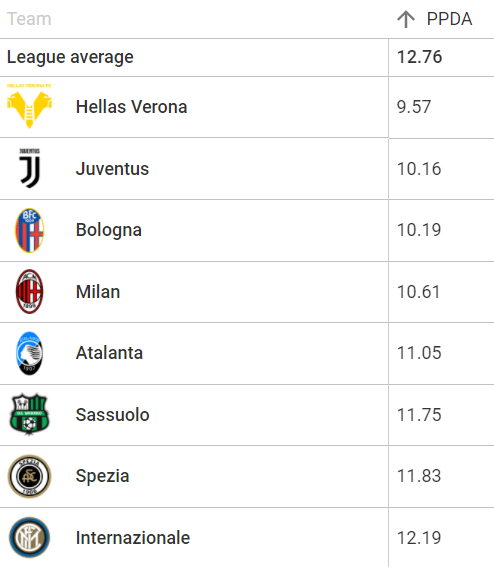
Sassuolo also have the second-highest expected goals against (xGA) in Serie A this season with a ridiculous 43.66 xGA, despite the fact that De Zerbi and his men are currently eighth in the division. In reality, they have conceded 34 goals and so despite how disastrous their backline has been at times, they are still overperforming, which is possibly the most worrying statistic.
Bypassing the press with long balls
Sassuolo begin pressing high up the pitch when their opponents are in the build-up phase of attack. They maintain their 4-2-3-1 base structure when pressing and use a man-oriented system.
They are quite efficient in their high press and as stated in the previous section, have one of the lowest PPDAs in the top-flight division.
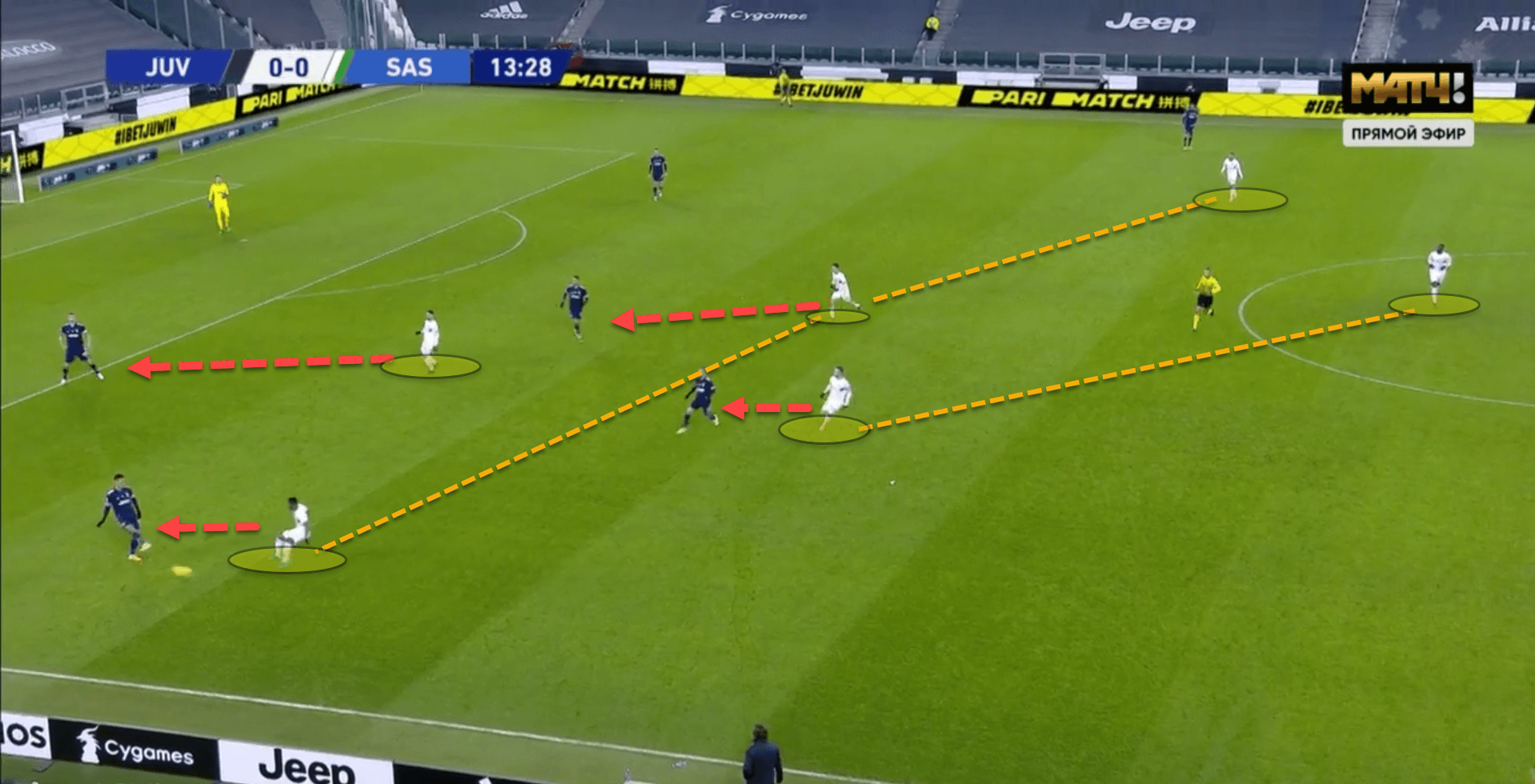
Here, we can see Sassuolo’s man-oriented high pressing system whilst maintaining a 4-2-3-1 structure. The players get very tight to their man, particularly those marking players closest to the ball, as we can see in the previous image.
Their high press is quite efficient due to its intensity and the fact that De Zerbi’s side can be very relentless for a full 90 minutes against an opponent. The objective when they press the opposition high up the pitch is to force them into the wide areas.
By forcing the opposite team into the wide areas, it limits the space they have to play in. When a player has the ball in the central areas, they can play the ball in all directions of the pitch, so by pushing the other team out to the flanks, Sassuolo severely limits the options available for the ball-carrier and then from there, I Neroverdi’s players will tightly mark the closest passing options. This makes it extremely difficult for the team in possession to play out of due to the limited passing lanes and gives Sassuolo a good chance of turning over possession.
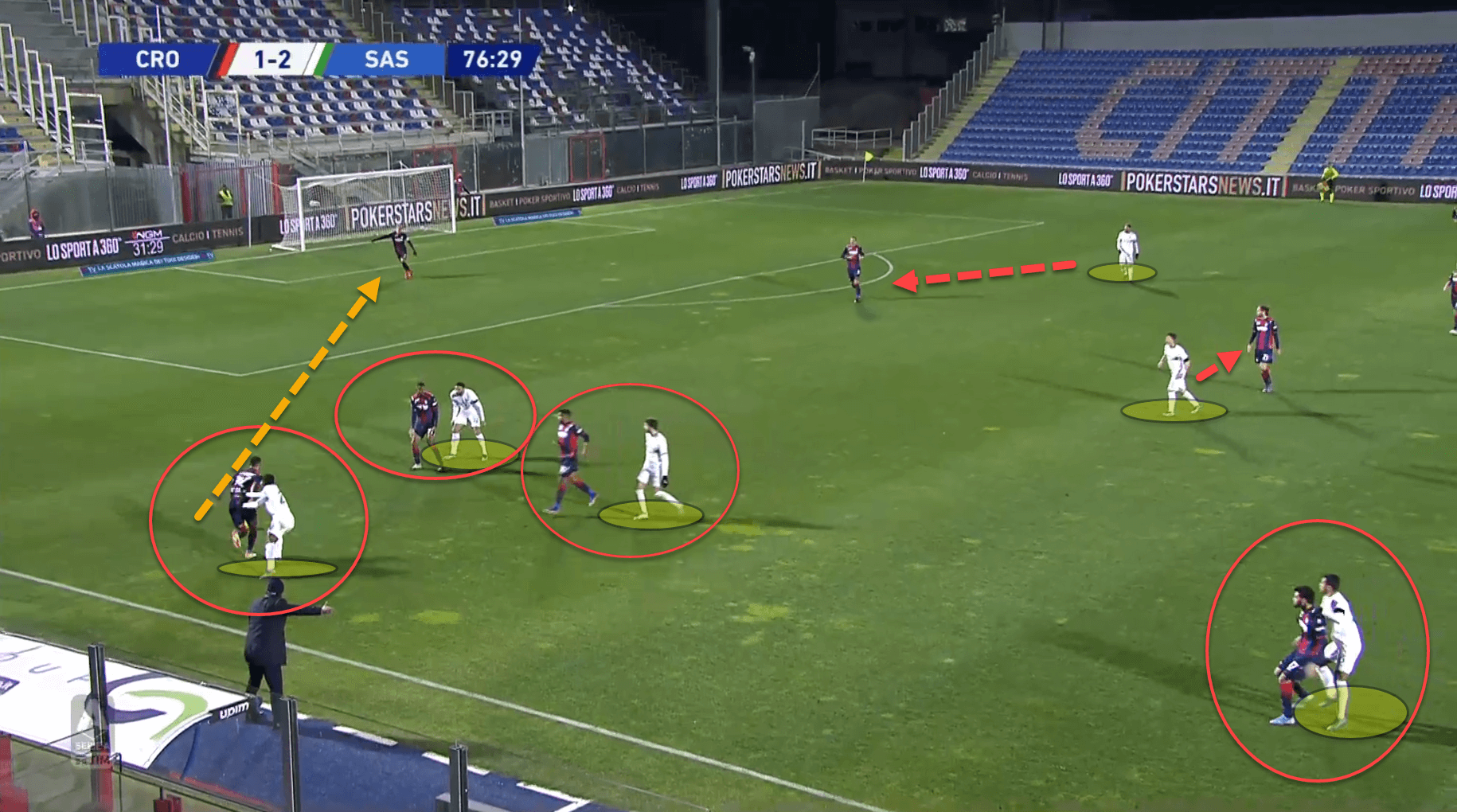
In this image, taken from a recent game, Sassuolo have pushed Crotone out wide with their pressing scheme and from there cut off all passing lanes, which eventually forced the fullback to play back to the goalkeeper, or else he would have lost possession for his side.
These are examples of when Sassuolo’s press works very well. However, like most man-to-man pressing systems, when the team in possession manages to bypass the first two lines of pressure, it leaves the backline severely exposed.
One-way teams play through Sassuolo is by playing long balls. Defending long balls is one of Sassuolo’s weakest areas in terms of their defensive duties. As a team this season, they have averaged just a 48 percent success rate in aerial duels, which is one of the lowest in the league.
The problem for Sassuolo is that they use both players in their double-pivot to man-mark players out of possession and so oftentimes a gap can open up between them and the backline which can be exploited as there is a lack of protection for the centre-backs.
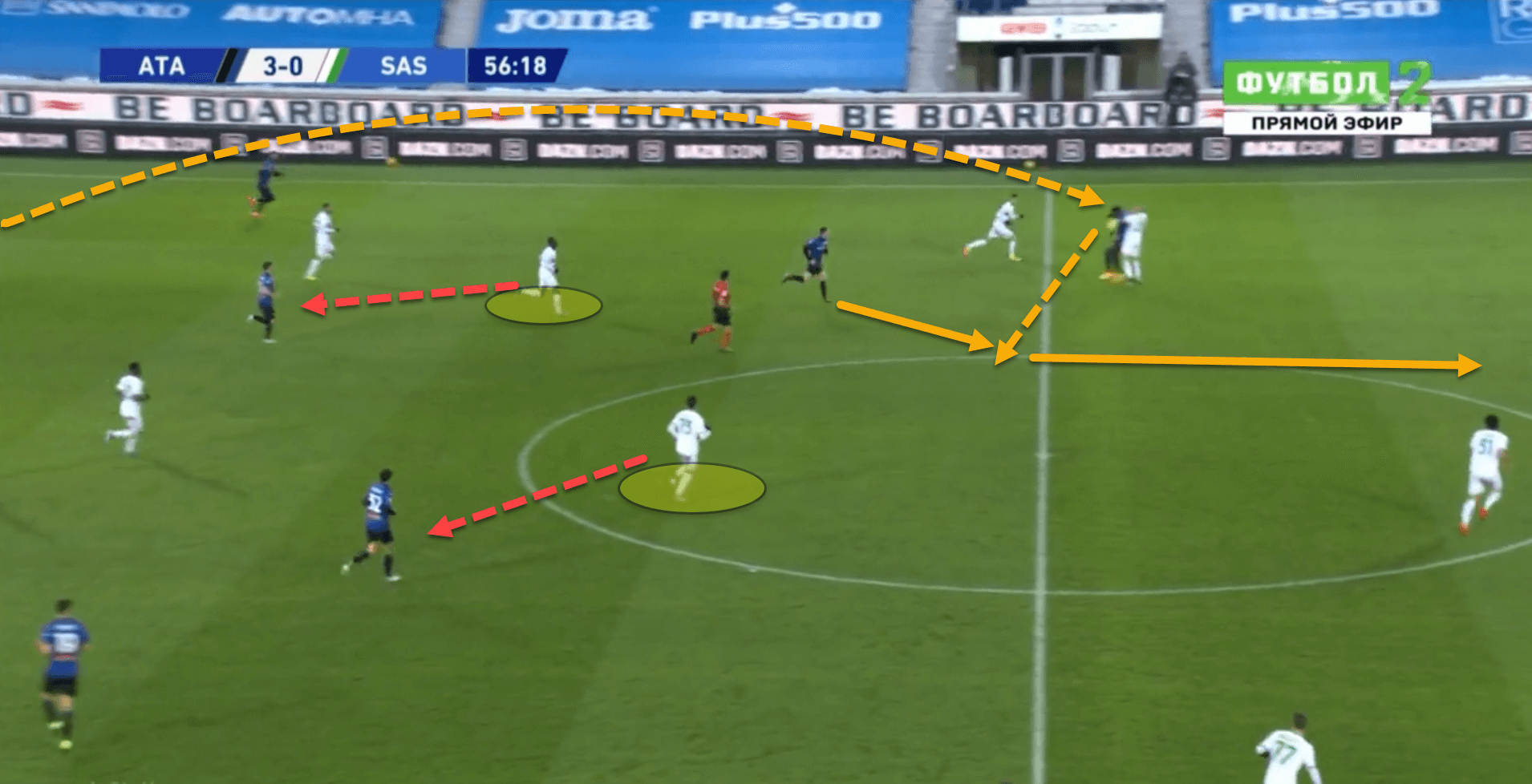
The image above is an example of Atalanta taking advantage of this space between the lines from a long ball, as well as taking advantage of Sassuolo’s backline’s lack of aerial prowess and protection.
Atalanta played a long pass to bypass Sassuolo’s press and Duvan Zapata manages to win the header and knock it down to Remo Freuler who moved into the space behind I Neroverdi’s double-pivot. Since the two holding midfield players were pushed high up the pitch marking their opposite numbers, there was nobody protecting the backline from second balls should Atalanta play long.
Freuler latched on to the knockdown from Zapata and drove forward with the ball before scoring. Tactically, this is quite a risky defensive structure. Whilst it makes life difficult for the opposition to play out from the back as Sassuolo are pressing high with six players, it leaves the back four greatly exposed and deprived of protection for when the opposition bypass the press.
Dragging players out of position
Generally, when a team breaks Sassuolo’s first line of pressure and move into a positional attack or the second phase as some analysts call it, De Zerbi’s men drop into a mid-block. The shape tweaks with the wingers dropping slightly deeper to create a 4-4-1-1 defensive shape.
However, the principle of man-marking the opposition remains. Man-marking opponents when sitting deeper on the pitch can cause quite a lot of problems, which are evident when Sassuolo are in the defensive phases. The biggest problem it causes is that the team in possession can create space between the lines by using slight movements or rotations with their central midfielders.
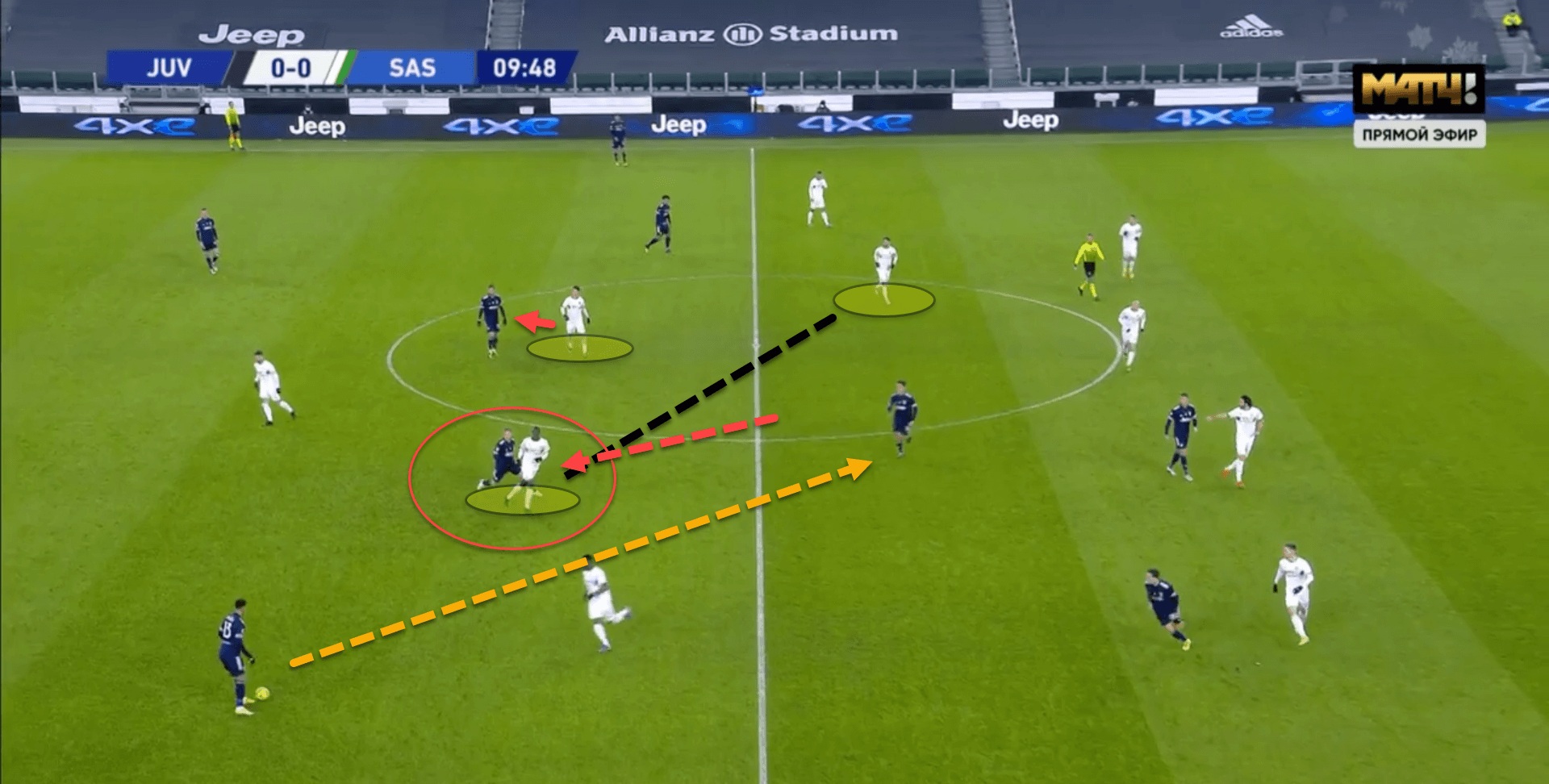
In this instance, Juventus created space successfully against Sassuolo with subtle midfield movements. Pedro Obiang has moved out of position naively to close down the passing lane to his man, Arthur Melo, whilst Traore is closing down Danilo on the ball.
Paulo Dybala saw the gap open up due to Sassuolo’s man-marking defensive system and made an angle for Danilo to play a forward pass between the lines, which eventually led to a chance for Juventus.
Had Obiang remained in front of the backline, and instead allowed the number 10, Djuricic, to come across and cover Arthur, this could have been easily avoided and Danilo would have had to play down the line or backwards instead.
Naïve situations like this leave Sassuolo’s backline exposed and make it far too easy for the opposition to find space in between the lines. Situations like the one shown in the previous image will need to be cut out if De Zerbi’s side want to improve their defensive record and leak goals.
Failure to stop and defend crosses
One of Sassuolo’s biggest weaknesses from a defensive point of view is their ability to stop crosses. I Neroverdi have conceded numerous goals this season from crosses. It is not just their ability to stop the crosses at the source, they also fail to clear the ball when it is played into the box.
There are a number of reasons for this, mainly their lack of a commanding centre-back, however, with the January transfer window closed, Sassuolo are unable to rectify the problem in the market.
Of course, football is not just as cut and dry as not having a commanding central defender at the club, there are many defects in Sassuolo’s defensive game that led them to concede many crosses into the box.
This season, they have conceded the third-highest amount of goals from headers in Serie A with 7, behind Parma and Sampdoria.
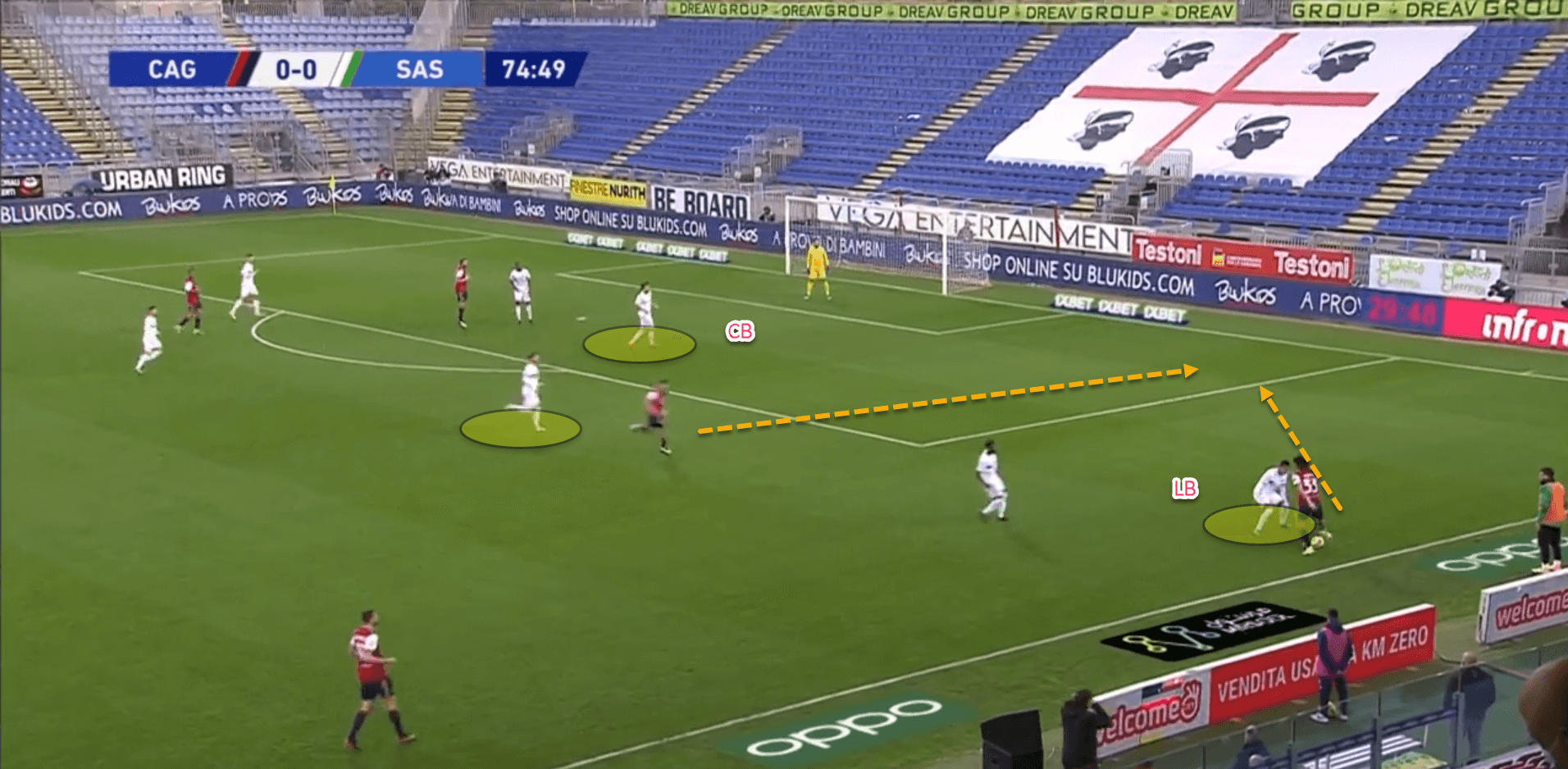
For instance, in this image, Sassuolo’s left-back pushes across to close down the Cagliari player on the ball in the wide area of the pitch. The three other players in the backline do not shuffle across to close down the space left, and instead the job of plugging the halfspace is left to the ball-near defensive midfielder.
This is a fine tactic when defending as it means that the team out of possession can sit with almost back five, but in this scenario, Sassuolo’s nearest holding midfielder fails to plug the gap in time and allows a runner to receive a pass on the blind-side of the left-back before cutting the ball back and scoring.
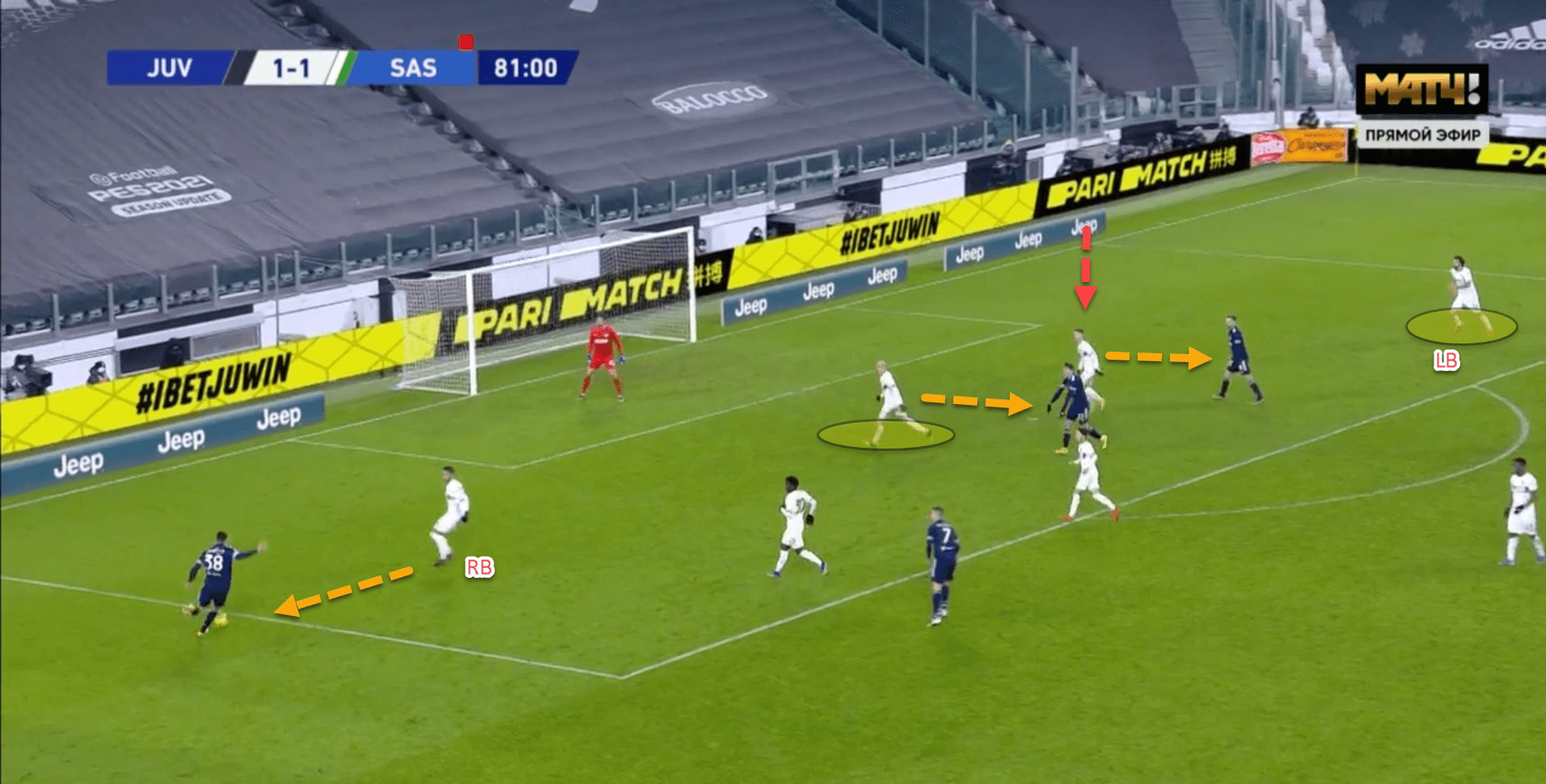
This image is a different situation where Sassuolo concede from a cross due to collective mistakes. Firstly, the right-back fails to stop the cross at the source and instead backs off hoping to block it rather than getting tight to the ball-carrier.
The ball is allowed to make its way into the penalty area and both of Sassuolo’s two central defenders are ball-watching with two Juventus forwards on their blind-side whilst the right-back sees the danger too late and doesn’t react quickly enough. Inevitably, the ball found its way to Aaron Ramsey who poked home.
Conceding goals is rarely ever just one person’s fault – it is generally a collection of errors that leads to a chance for the opposition. A team does not need ‘world-beater’ defenders to concede fewer goals and fewer chances, collective mistakes just need to be cut out, something which is definitely true for De Zerbi’s team.
Poor against counter-attacks
Finally, and rather briefly, another key area where Sassuolo struggle greatly is from opposition counter-attacks, when they are transitioning from attack to defence. This season, they concede an average of 3.71 counter-attacks per 90 in all competitions, but what is scarier is the fact that 40.4 percent lead to shots on their goal.
Sassuolo are a team that like to counterpress the opposition when they lose possession, particularly high up the pitch, but the danger within any counterpressing defensive system is that should the offensive team bypass the counterpress, Sassuolo are at a high-risk of conceding.
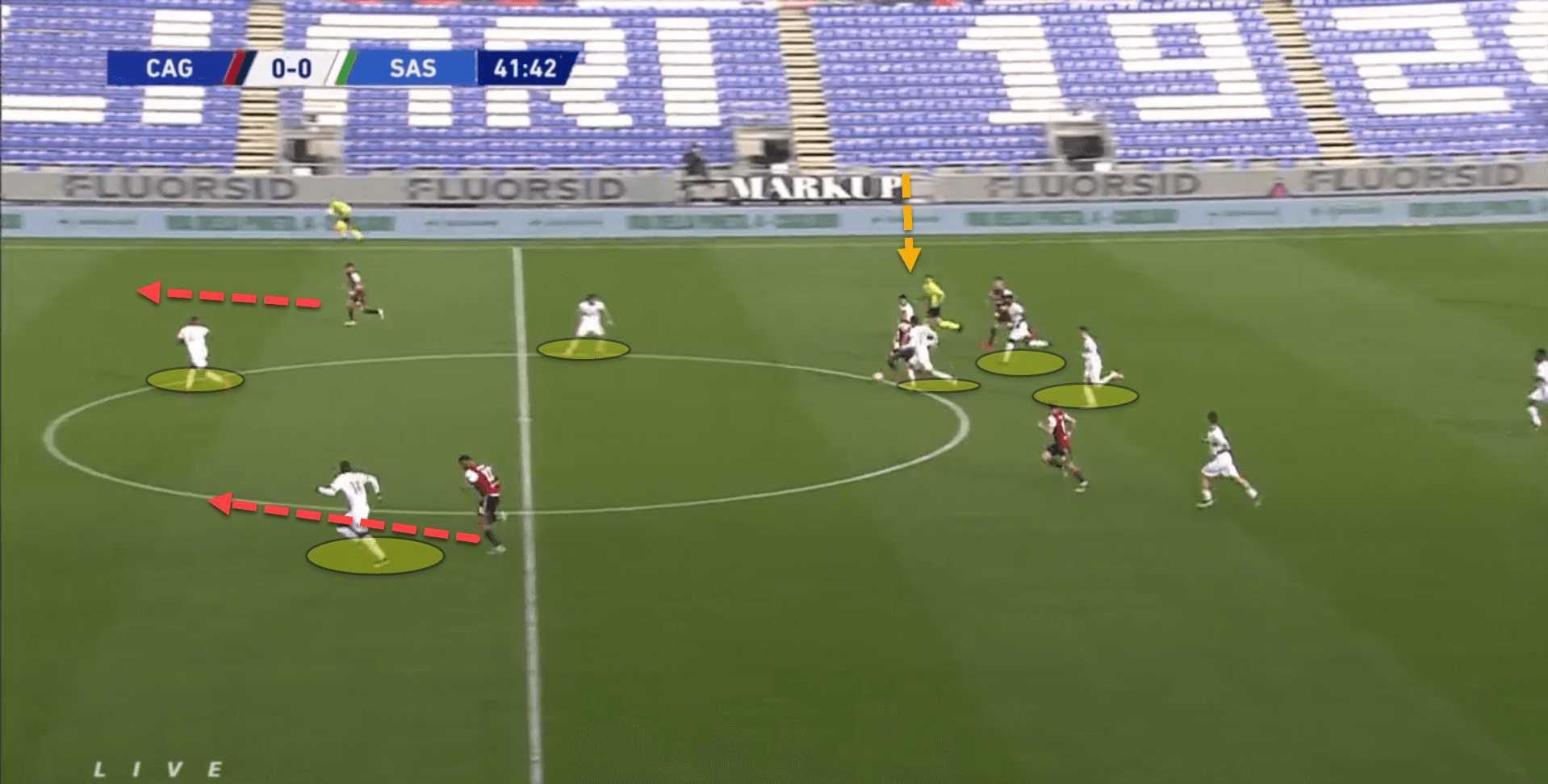
Here, Sassuolo lost the ball in the final third and used numerical superiority to try and regain possession by hunting down the player on the ball. However, Cagliari broke through the counterpress and now had a 2v2 against Sassuolo’s centre-back if the ball-carrier could play the ball forward quickly.
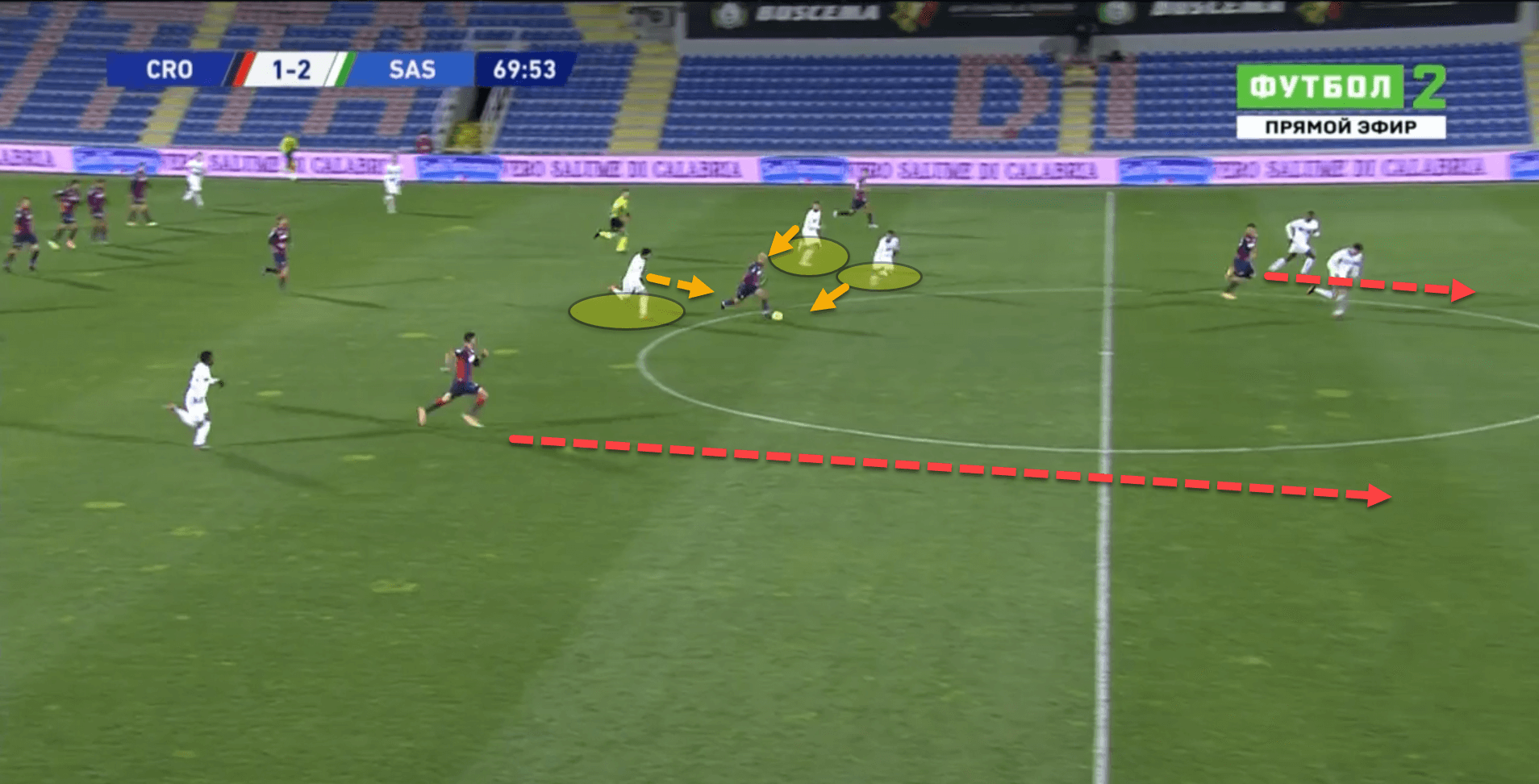
Again here, Crotone broke through Sassuolo’s counterpress and the two centre-backs were left exposed with no protection.
Counterpressing is not the problem for Sassuolo providing they have a good rest defence, but De Zerbi pushed both his holding midfield players up to press also. Perhaps a better rest defence would be to leave at least one of the double-pivot back to protect the backline.
Conclusion
From a neutral perspective, watching Sassuolo in Serie A this season has been a joy, as their games are always so open, but for the club themselves, this is not sustainable. They need to fix their defensive mistakes quickly or else they will find themselves slipping further and further down the table the more the season progresses.






Comments